
Presentation of results from field test “Efficiency Run 2015”
Magazine
Stuttgart / Berlin – Using technologies available on the market, the fuel consumption, and therefore the CO2 emissions, of modern truck combinations can be reduced by a double-digit percentage. This was the finding of a field test, the results of which were presented by Daimler Trucks in Berlin. This field test with the project name “Efficiency Run” is of great significance for achieving CO2 targets for road freight transport. This is because the Efficiency Run has demonstrated that fuel consumption, and therefore also CO2 emissions, can be significantly reduced – also at lower cost – if optimisation efforts focus not just on the engine of the tractor unit, but on the vehicle as a whole.
The series of tests was conducted by Daimler Trucks in cooperation with the leading German logistics companies DB Schenker Logistics, Grosse-Vehne and Elflein. This involved genuine freight being driven on genuine routes under realistic conditions. The tests were supervised in detail by the DEKRA testing organisation, which laid down the test conditions, carried out the measurements and evaluated the results.
One of the key results: the two Mercedes-Benz Actros standard semi-trailer combinations that were optimised for the Efficiency Run each consumed around 12 to 14 percent less fuel than standard semi-trailer combinations of the respective transport companies based on their fleets in 2014.
The Efficiency Run also investigated the potential of the Long Combination Vehicle – once again with a clear result. In the test, the Long Combination Vehicle showed a reduction in consumption of around 17 percent compared with the standard semi-trailer combination used in volume-based transport.
“We have proven: if we want to significantly further reduce both fuel consumption and CO2 emissions, we need to look beyond just the engine. We must widen our focus to include tyres, semitrailer and other key components. This is the only way in which we can achieve our objective in an affordable manner,” stated Dr. Wolfgang Bernhard, member of the Board of Management of Daimler AG responsible for Daimler Trucks & Buses.
“Our test also confirms the formula that two Long Combination Vehicles have the same transport capacity as three conventional semi-trailer combinations – with significantly higher efficiency and lower impact on the environment,” said Dr Bernhard.
Stefan Buchner, Head of Mercedes-Benz Trucks: “Our aim is to ensure that customers who buy a Mercedes-Benz Actros have the most efficient vehicle in its class. So, naturally, we were especially keen to see how much more optimisation is possible on the vehicle as a whole. Reductions of up to 14 percent on the standard semi-trailer combination and 17 percent on the Long Combination Vehicle clearly exceeded our expectations.”
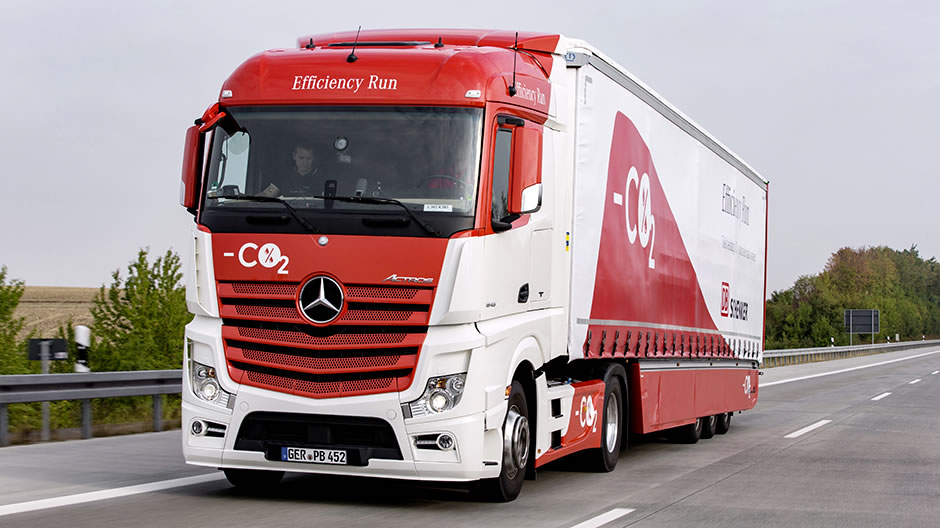
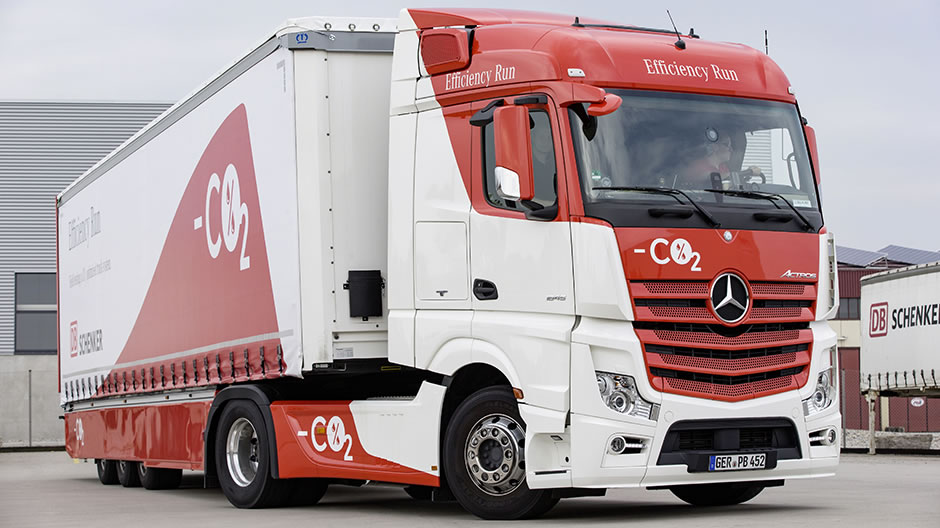
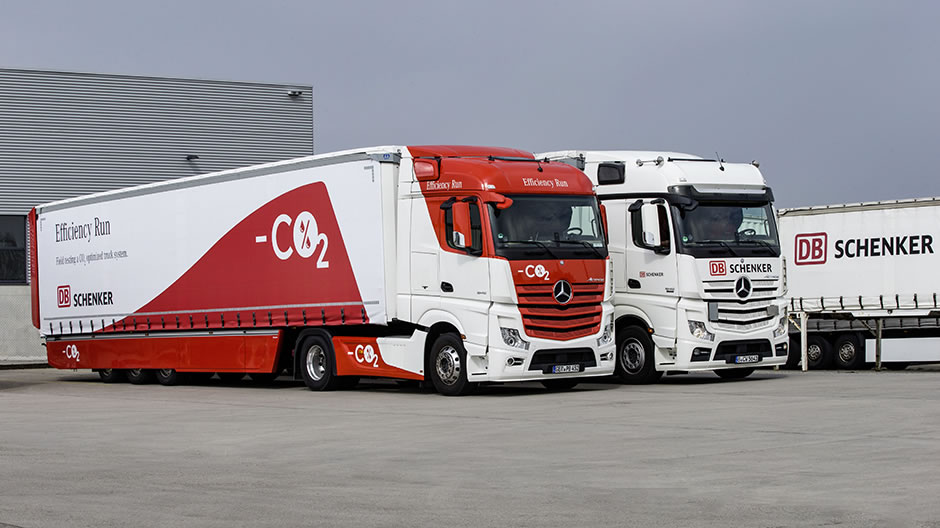
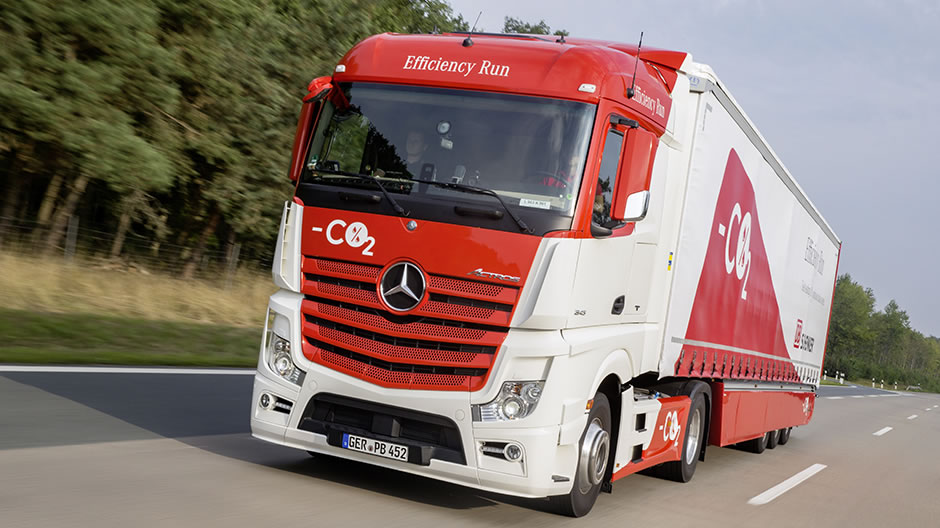
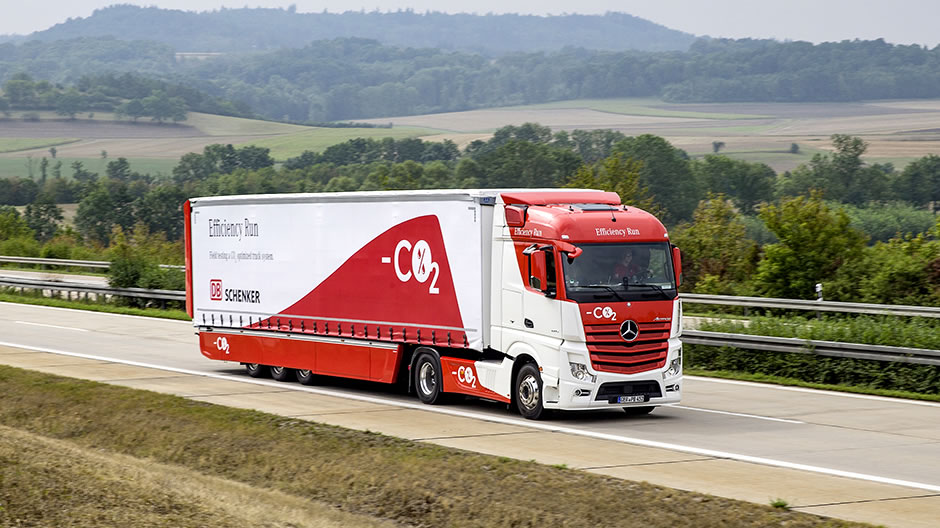

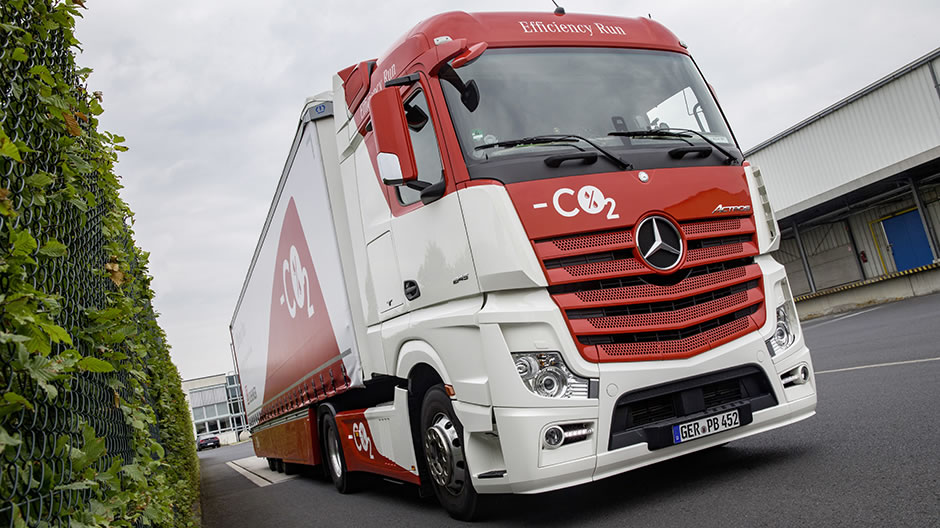
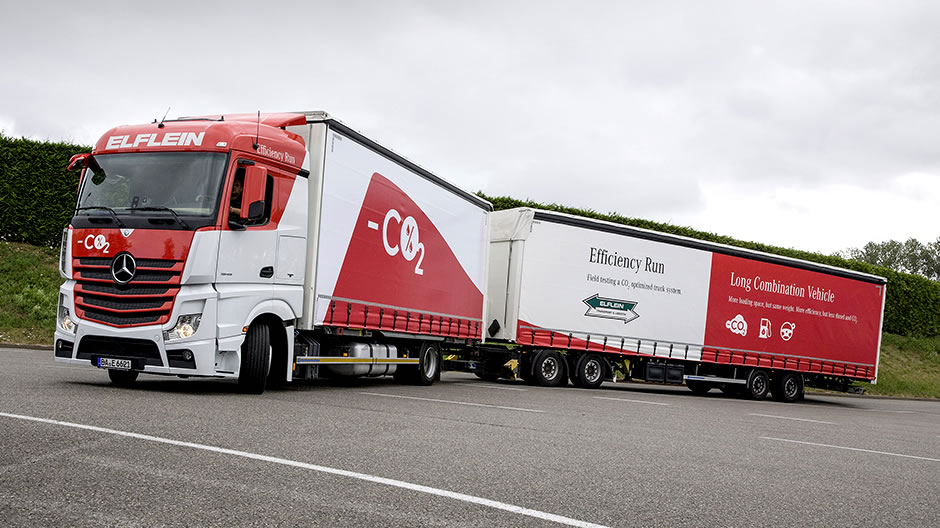
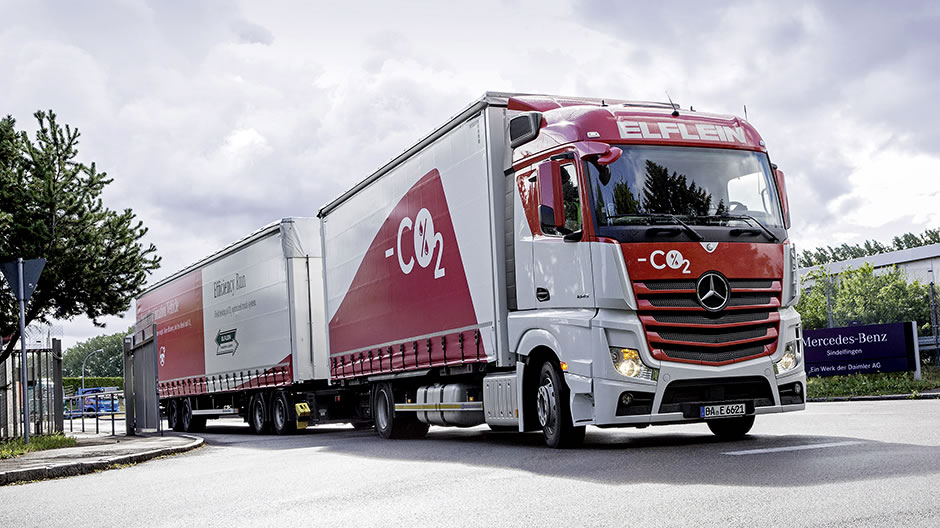
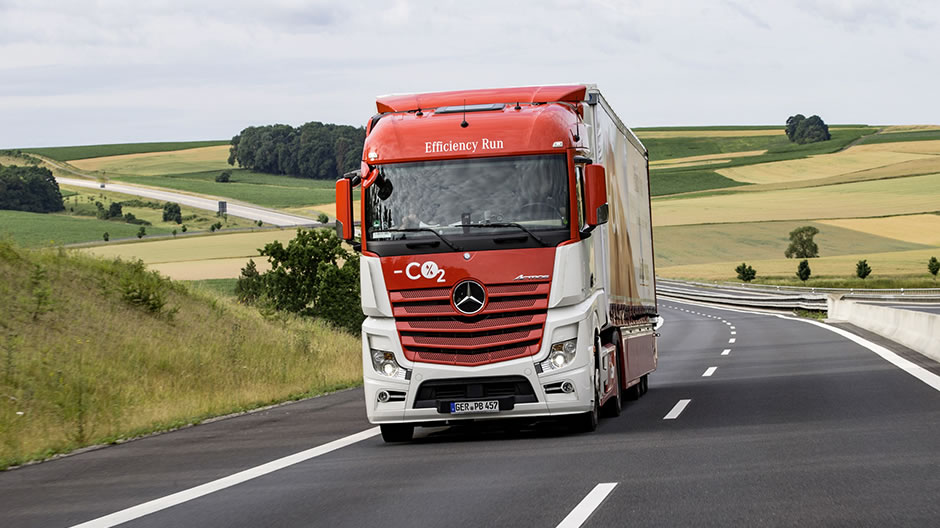
European commercial-vehicle manufacturers have already achieved a great deal on the CO2 front: for example, fuel consumption per tonne-kilometre has been reduced by around 60 percent since 1965 and, over the same period, six exhaust emissions standards have been put into practice. This demonstrates that the most effective regulator for a commercial-vehicle manufacturer is the customer. With fuel costs making up almost one-third of the total cost of ownership (TCO), customers are constantly calling for fuel consumption to be minimised. In consequence, Daimler Trucks has always made every effort to supply customers with vehicles that are as efficient as possible.
All commercial-vehicle manufacturers are currently confronted with new CO2 targets for road freight transport. Thus, the EU intends to achieve a CO2 reduction of 30 percent by 2030 (compared with 2005). For Germany, a reduction of even 40 percent is under discussion. Against this backdrop, it is necessary to adopt new approaches, because it is no longer enough to focus exclusively on the tractor unit. To be able to achieve even more significant – yet affordable – reductions in CO2 emissions in the future, politicians and the transport industry must join forces and adopt an integrated approach.
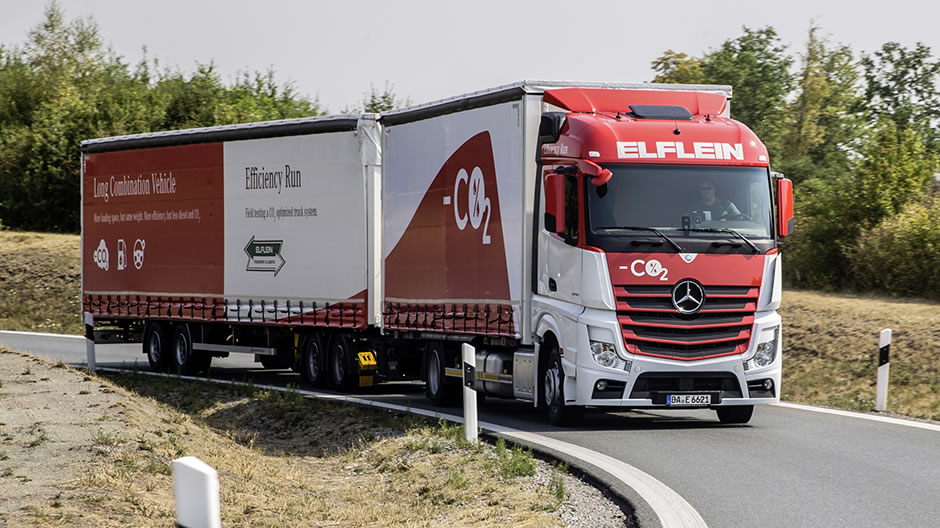
The goal, therefore, is to adopt a so-called integrated approach in which all the actors involved in road freight transport take part in achieving the targets: commercial-vehicle manufacturers, body/tyre suppliers, logistics companies and, last but not least, politicians. Daimler Trucks presented this concept together with other European manufacturers at the 2014 IAA for Commercial Vehicles.
The objective of the integrated approach is to optimise the entire truck/transport system. In addition to the tractor unit, consideration is given also to the semitrailer (e.g. weights and dimensions, air resistance, lightweight design), tyres (e.g. rolling resistance, air pressure, single tyres) and fuel (e.g. biofuel, natural gas). Yet the integrated approach also attaches importance to vehicle operation (e.g. driver training, cargo pooling), infrastructure and the issue of fleet renewal. The Efficiency Run has now demonstrated that the integrated approach works in real-world practice.
For the Efficiency Run, Daimler Trucks and the three logistics companies focused on the vehicle-specific optimisation potential. The requirements for the Efficiency Run can be reduced to a simple formula: as close to the real world as possible. This means that the test should use standard tractor units with standard powertrains. The Mercedes-Benz vehicles in the configurations Actros 1842 and Actros 1845 with 3700 mm wheelbase were optimised exclusively using components that are currently available on the market. Sporting distinctive red/white colours, the two Actros Efficiency Run semi-trailer combinations from the fleets of DB Schenker and Grosse-Vehne that took part in the field test were equipped with Predictive Powertrain Control (PPC).
The Actros tractor units were hooked up to weight-optimised Krone Eco semitrailers, which are likewise available on the market in this form. Similar variants have long been available from the vehicle manufacturer.
In addition to the lower kerb weight thanks to lightweight design and the use of aluminium instead of steel at the front and rear, the Eco semitrailers were aerodynamically optimised for the Efficiency Run with side panelling, Wabco OptiFlow Tail (foldable rear spoilers), rounded-off underride guard, removal of stowage boxes, low-weight aluminium support legs and drip edge. Optimisation of the vehicles was rounded off with low rolling-resistance tyres.
The Long Combination Vehicle with a two-axle Actros 1845 platform truck and four-axle semitrailer was identical to the standard combinations used by Elflein, the third participating transport company. Headquartered in Bamberg, the firm now has one of the largest fleets of Long Combination Vehiclesin Germany.
The reference vehicles for the one-week tests at DB Schenker and Grosse-Vehne were standard semi-trailer combinations from the fleets of the transport companies at the time the project began in late 2014 and that had similar mileages to the Efficiency Run vehicles. Also for the test drives with the Long Combination Vehicle, the reference vehicle was a tractor unit with standard semitrailer to allow a comparison between a standard combination and a standard Long Combination Vehicle.

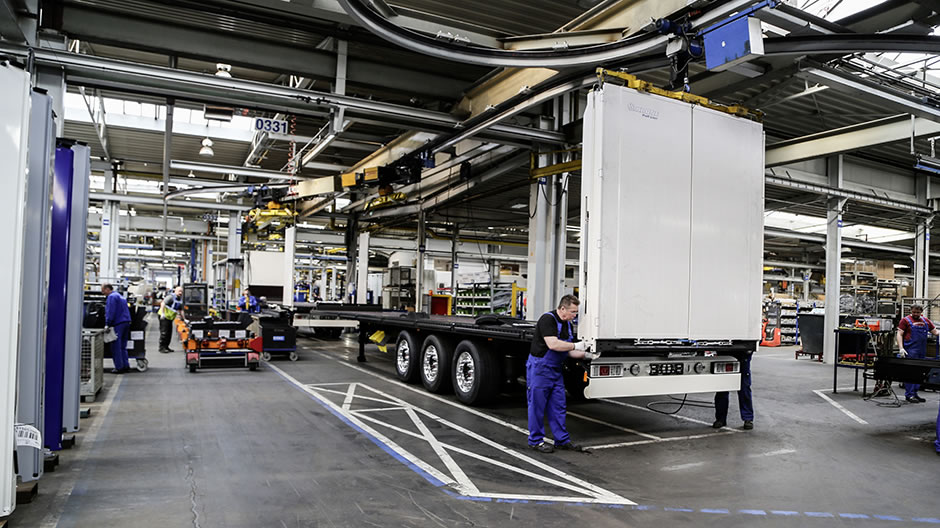
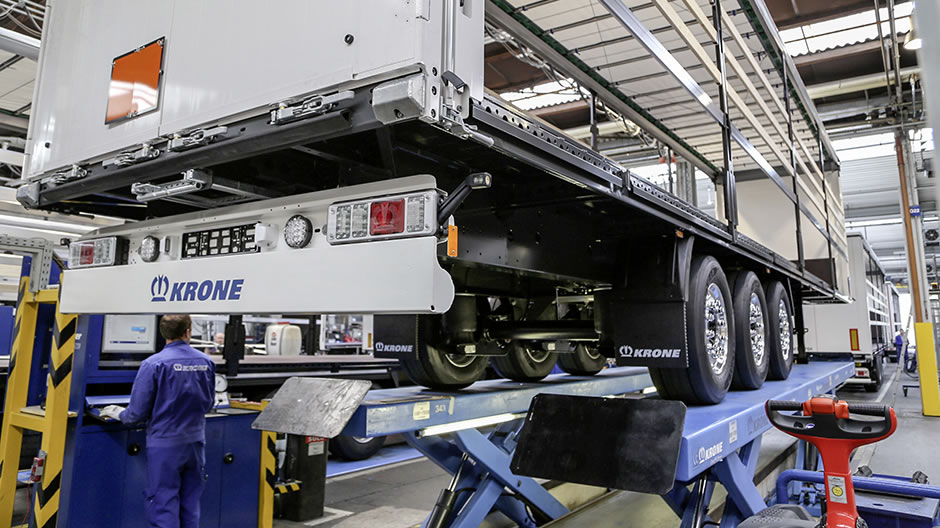
A comprehensive evaluation of the collected data by DEKRA delivered a clear result: fuel consumption can already today be optimised at acceptable cost using components available on the market. The results far exceeded the test team's expectations.
Rolf Deisinger, Head of Testing for Truck Powertrain Integration and Fuel Consumption at Mercedes-Benz Trucks, who was in charge of conducting the Efficiency Run, adds: “The reduction in fuel consumption was due almost 50/50 to the Actros tractor unit and the semitrailer. This confirms our belief that the entire system needs to be taken into consideration. The integrated approach is the right one as we search for fuel- and cost-efficient solutions.”
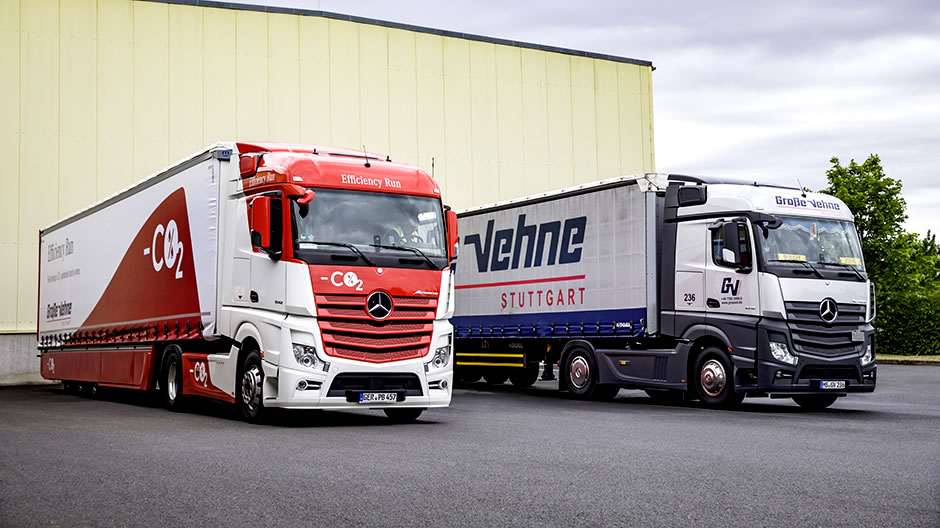
The use of Long Combination Vehicles in the field test of the Federal Highway Research Institute (BASt) is the subject of a highly emotional debate in Germany. Although there is no doubt that these vehicles are not suitable for use in every case, given a reasonable combination of transport task and cost/benefit relation, Long Combination Vehicles can make a significant contribution to lowering CO2 emissions. The main focus with such trucks is on the transport of bulky goods of relatively low weight.
The DEKRA study as part of the Efficiency Run first revealed the expected extra consumption of 23.8 percent for Elflein's Long Combination Vehicle in comparison with a standard tractor unit with mega-trailer. Next, the DEKRA engineers calculated the relationship between the measured fuel consumption of the Long Combination Vehicle with higher transport capacity and the volume-based transport capacity. This emphatically confirmed the formula 2 = 3.
This means that the transport capacity of two Long Combination Vehicles is the same as that of three standard semi-trailer combinations. In terms of the CO2 balance, there was a 17 percent reduction in emissions due to the lower number of journeys within the selected testing framework.
Dr Wolfgang Bernhard: “As a manufacturer, we do not look at the issue of Long Combination Vehicles in isolation. We are sure that these vehicles represent an extremely attractive alternative for the entire transport industry.”
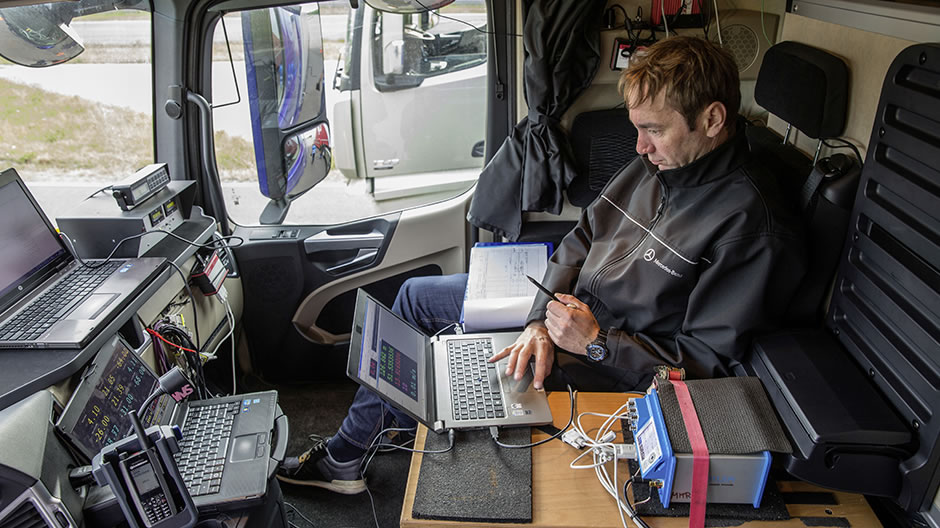
Before the three consumption-optimised combinations and the respective reference vehicles went out on their test drives, Daimler test engineers, representatives from the three transport companies and DEKRA test experts met up to define the test parameters for the Efficiency Run 2015.
Uwe Burckhardt, Process Manager and Deputy Head of the DEKRA Automobile Test Centre: “We wanted the comparison between the reference vehicles from the fleets of the participating companies and the consumption-optimised vehicles to take place under realistic conditions, be reproducible and deliver meaningful results of high quality. We went to considerable lengths to achieve this.”
First of all, a team of fuel-consumption and CO2 experts from Daimler Trucks went to the DEKRA testing ground at the Lausitzring in Klettwitz to measure the air drag and rolling resistance of the semitrailers according to the ACEA method. At the same time, discussions were held with Mercedes-Benz Trucks concerning possible routes for the Efficiency Run. This led to a decision being taken in favour of routes that were used in day-to-day operation by the three transport companies. Finally, the drivers were given instruction in an effort – away from their individual driving styles – to ensure approximately identical conditions (such as with regard to air conditioning of the cab or manoeuvring/overtaking procedures). One of the declared goals for the Efficiency Run was to reduce the influence of the driver on fuel consumption in order to allow a “machine against machine” contest to the maximum possible extent.
During the field test, all events – such as traffic jams, traffic light stops, manoeuvres, empty runs or “slipstreaming” behind slower vehicles, the percentages of city/country road/motorway driving as well as the wind conditions (strength and wind direction) – were recorded in-cab by DEKRA experts or by on-board cameras in order to assess the relevance of external influences. In addition, the Fuel Efficiency and reference vehicles took turns in front after every stop; the trucks set off at 10-minute intervals from loading/unloading points, after breaks or stops at the testing site. At the end of each stage, the two drivers swapped places at the wheels of the reference and test vehicles.
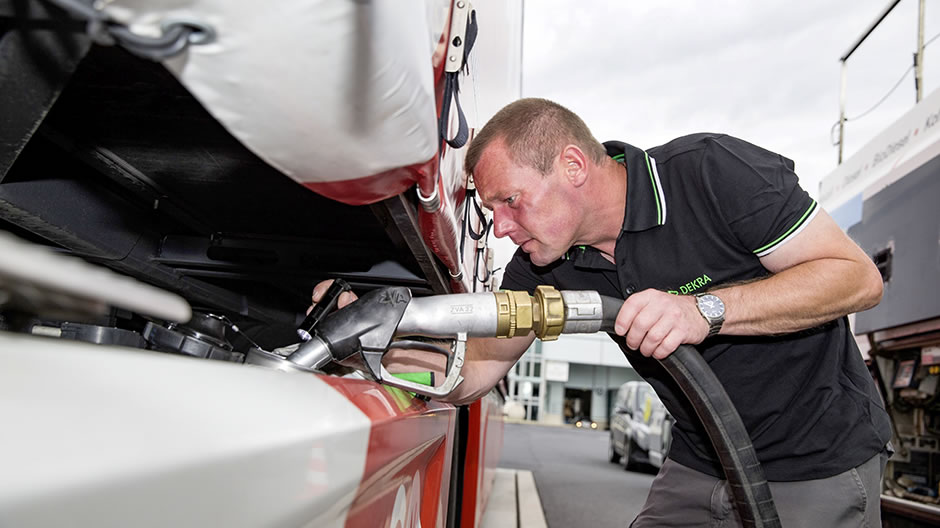
Special care was taken to accurately measure the fuel consumption. Uwe Burckhardt: “With such a test, it's important not just to refuel, but also to bring the data into relationship with the routes and conditions.” During the tests, the trucks were refuelled by a calibrated tanker vehicle to guarantee an identical fuel quality and temperature. The fuel used was tested for its fatty acid methyl ester content, percentage of bio-diesel and volume fractions of carbon, oxygen and hydrogen. Immediately before each refuelling, 150 litres of diesel were pumped off to avoid the temperature differences that can arise in the pipe of the tanker vehicle in hot weather. The fuel was measured using a calibrated flowmeter on the tanker vehicle. The DEKRA experts filled up the vehicles first with the pump nozzle and then using a measuring glass. After refuelling, the vehicles were driven over a weighbridge to allow their total and axle-by-axle weight to be documented.
In the course of the field test, the DEKRA test engineers also had access to the measurement results from the Daimler FleetBoard telematics service, which is now part of the standard equipment on Actros tractor units. This Daimler subsidiary has been supporting every aspect of driver, vehicle and transport management for fleets with a suite of modular services. On the one hand, this allows drivers to directly check and improve their fuel-efficient driving style. On the other hand, the DEKRA experts were able to use “FleetBoard Performance Analysis” to study wear- and consumption-relevant factors such as anticipatory driving style, changes of speed or braking behaviour. Furthermore, FleetBoard certified that all the truck drivers taking part in the Efficiency Run had an absolutely professional driving style. On the FleetBoard rating scale from 1 to 10, they were all rated above 9.5.
Uwe Burckhardt's verdict: “Due to the fact that our measuring methods allowed us to record and evaluate a high number of results, this fuel consumption test under real-world conditions has ultimately delivered statistically valid information on the achieved consumption figures.”
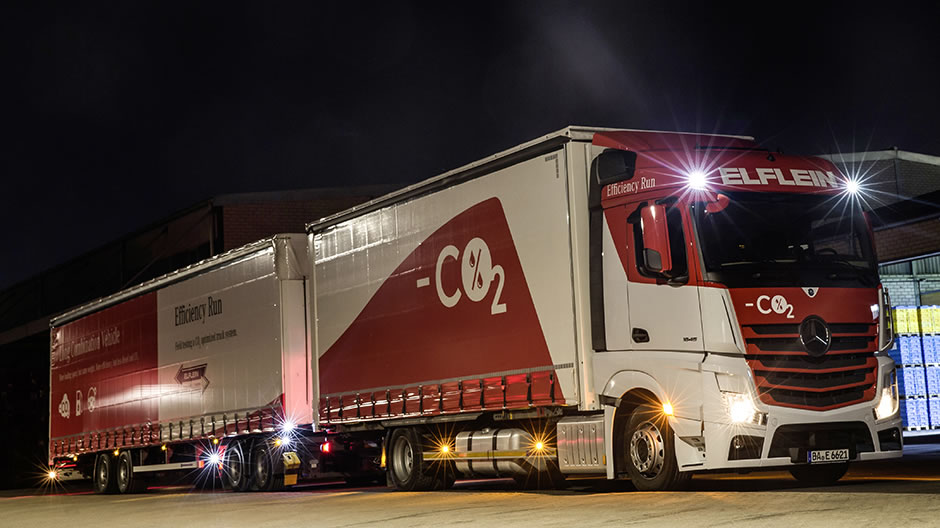
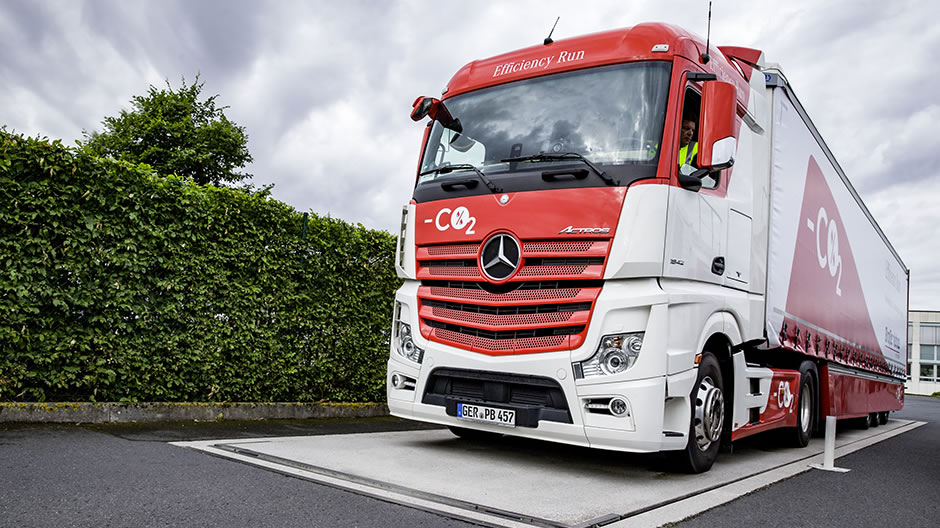
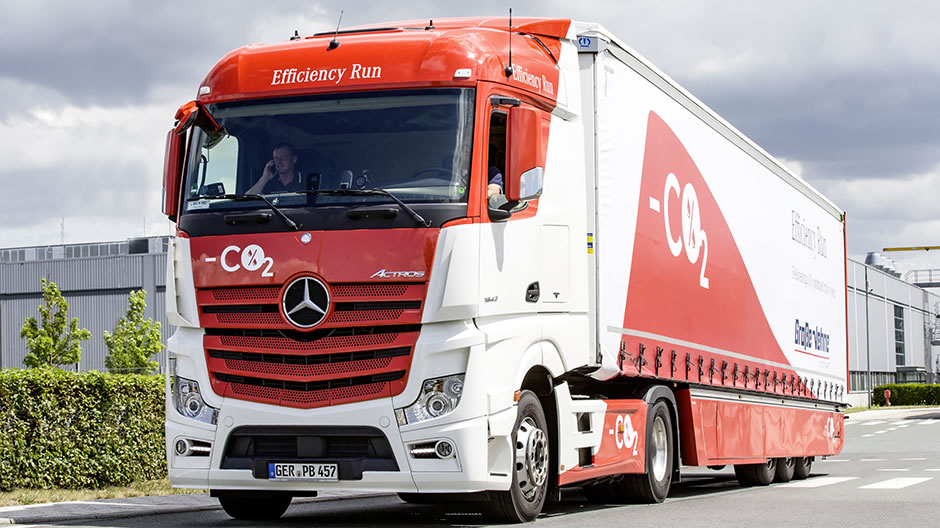
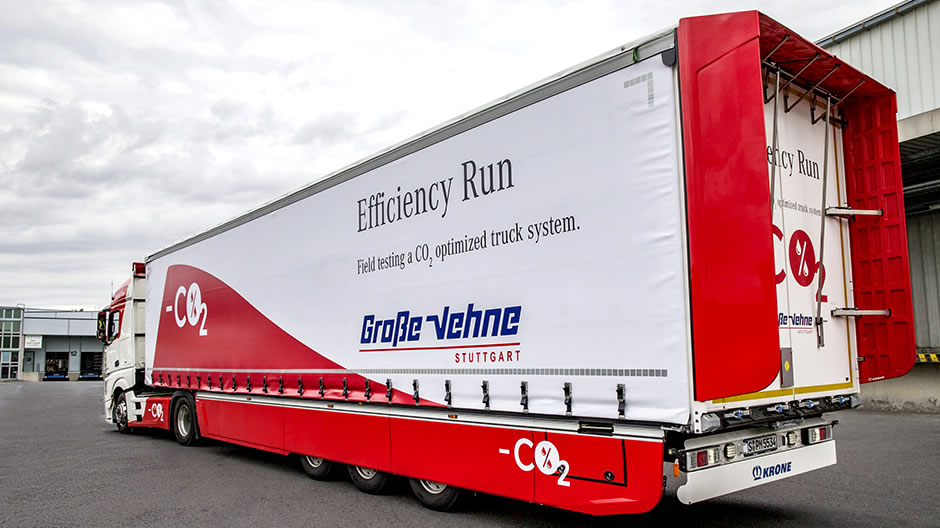
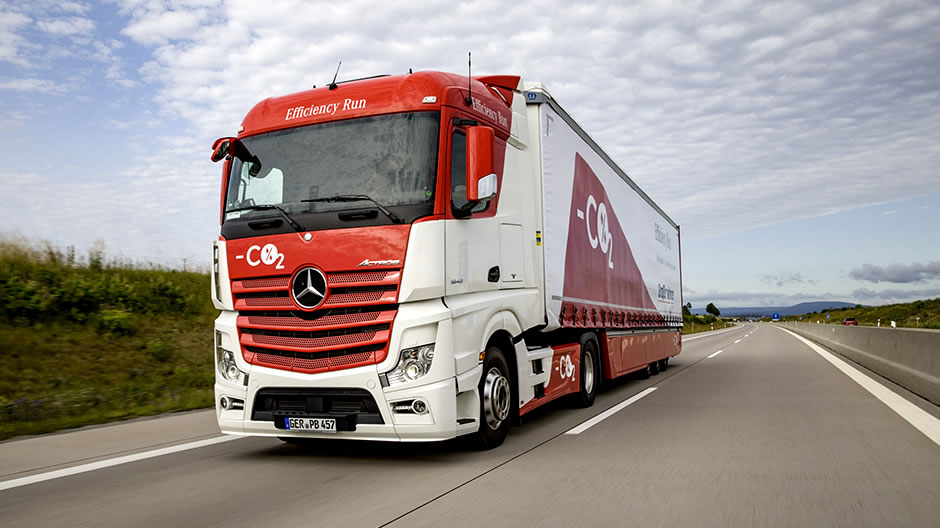
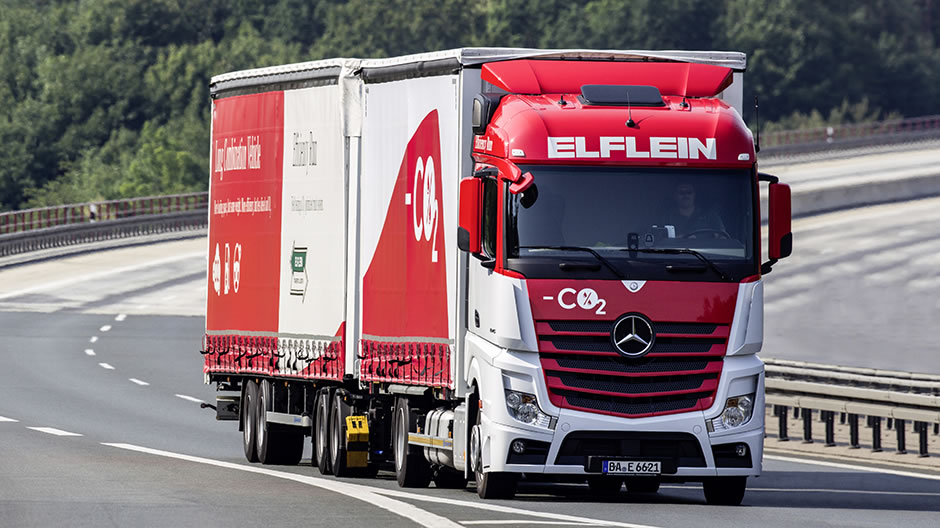
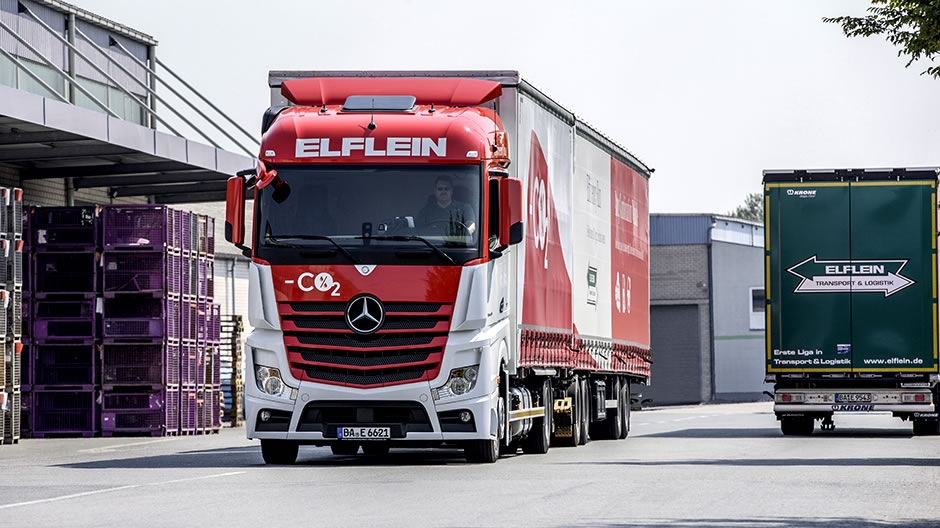
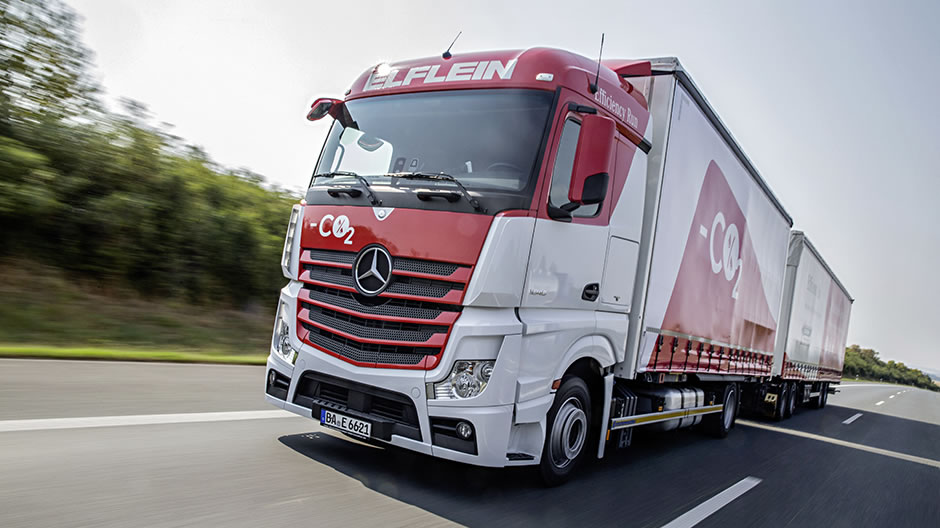
For Daimler, this successful test resulting in double-digit fuel savings with a consequent reduction in CO2 emissions is an incentive to push ahead vigorously with the current approach. Dr Wolfgang Bernhard: “The Efficiency Run was conceived as a real-world field test – we have now successfully completed it. We have clearly exceeded our goal of six percent fuel saving. The Efficiency Run was a first step, which will be followed by other ones. We feel sure that this will uncover additional potential that will not only make our trucks even more environmentally compatible, but will also be economically acceptable to cost-conscious transport companies."
Efficiency Run Tractor unit Mercedes-Benz Actros used by
DB Schenker/Grosse-Vehne.
| Cab: | L-cab, StreamSpace 2.5 m, wheelbase = 3700 mm |
| 765 ASH (flat floor) | |
| Engines: | OM 471, 310 kW / 420 hp with TopTorque (Grosse-Vehne) |
| OM 471, 330 kW / 450 hp with TopTorque (DB Schenker) | |
| Mileage: | approx. 50,000 km (vehicle), approx. 5000 km (semitrailer) |
| Cruise control: | Predictive Powertrain Control |
| Transmission: | Mercedes-Powershift 3 (G 211) |
| Retarder: | none |
| Axle: | irear = 2.611 |
| Tyres on tractor unit: | Front axle: Goodyear Fuelmax S: 315/70 R 22.5 |
| Rear axle: Goodyear Fuelmax D: 315/70 R 22.5 | |
| Semitrailer: | Krone Eco semitrailer incl. side panelling and rear end taper |
| Tyres on semitrailer: | Goodyear Fuelmax T: 385/55 R 22.5 |
| Tank capacity: | Diesel tank, left: 570 l |
| Diesel tank, right: None | |
| AdBlue tank: 75 l |
Efficiency Run Long Combination Vehicle Mercedes-Benz Actrosused by Elflein.
| Cab: | L-cab, StreamSpace 2.5 m, wheelbase = 5800 mm |
| 765 ASH (flat floor) | |
| Engine: | OM 471, 330 kW (450 hp) with Top Torque |
| Cruise control: | Predictive Powertrain Control |
| Transmission: | Mercedes-Powershift 3 (G 211) |
| Retarder: | Secondary water retarder |
| Axle: | irear = 2.412 |
| Tyres on vehicle: | Front axle: Goodyear Fuelmax S: 315/60 R 22.5 |
| Rear axle: Blackline: 295/60 R 22.5 | |
| Semitrailer: | Krone SDAH |
| Tyres on dolly /semitrailer: | Krone SDAH 445/45 R 19.5 |
| Tank capacity: | Diesel tank, left 500 l |
| Diesel tank, right: 500 l | |
| AdBlue tank 75 l |
DEKRA.
Established in Berlin in 1925, this German motor vehicle inspection association is today a globally active, independent expert organisation with headquarters in Stuttgart. Last year, DEKRA posted sales of around 2.5 billion euros with some 35,000 employees.
While, at the start of the automotive age, the focus was on the safety of motor vehicles and their (voluntary) inspection, the organisation now has three business units: DEKRA Automotive, DEKRA Industrial and DEKRA Personnel. These three units cover a total of twelve strategic business areas. These include vehicle testing, expert opinions, automotive solutions, homologation and type approval, claims adjustment, industrial and design & construction testing, materials testing and inspection, product testing and certification, business assurance, insight (consulting), training and temporary work.
Directly next to the Lausitzring in Klettwitz, DEKRA operates a Technology Centre that can be rented by vehicle and component manufacturers. DEKRA also offers a range of services there, such as the testing of vehicles, vehicle components or assemblies.
DB Schenker.
DB Schenker is responsible for the transport and logistics activities of Deutsche Bahn. DB's logistics division ranks second – in sales and performance – among the world's largest transport and logistics companies. It has over 64,000 employees with sales of 14.94 billion euros.
DB Schenker maintains a global network with around 2000 sites in all key economic regions of the world. This success is founded on its 95,700 employees. In the 2014 fiscal year, DB Schenker posted sales of approximately 19.8 billion euros - around 50 percent of the DB Group's sales.
DB Schenker has a worldwide presence in some 140 countries. It thinks globally while acting locally. The company is a one-stop provider of integrated services: complete transport chains across all modes of transport – rail, road, sea and air – combined with complex additional logistical services.
While systematically adjusting to a growing awareness of climate protection, the parent company, Deutsche Bahn, has launched the DB Climate Protection Programme 2020. With this programme, the DB Group is seeking to lower its specific CO2 emissions, i.e. its emissions per transport unit, by a further 20 percent between 2006 and 2020.
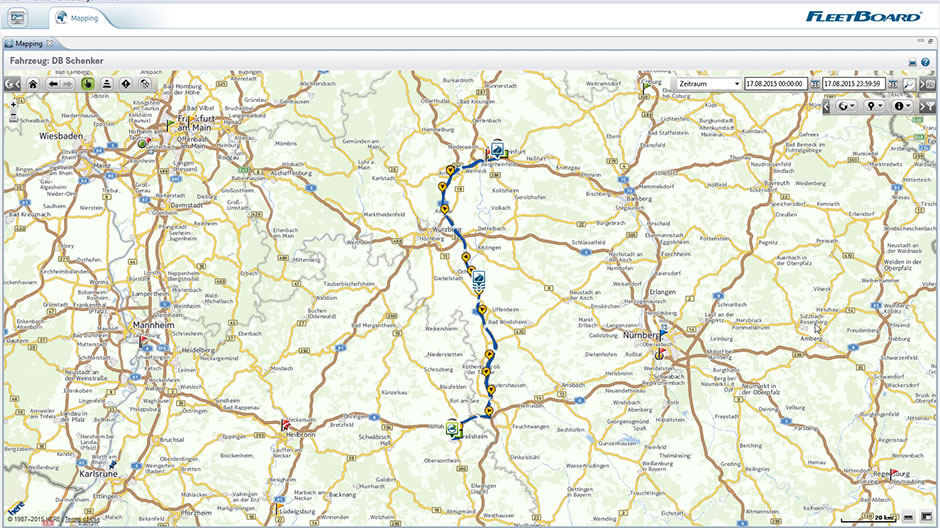
Elflein.
Elflein Spedition & Transport GmbH is a provider of high-quality and innovative transport and logistics services at eleven locations in Germany and the Czech Republic, where it has a total workforce of over 700 employees. With a fleet of 375 trucks, the company has developed over the years into a key service provider to the paper, food and automotive industries. Sustainability and innovation are core elements of Elflein's corporate policy, as is impressively confirmed by its use of Germany's largest fleet of Long Combination Vehicles. Elflein's goal is to gradually reduce the fuel consumption of its truck fleet. Thus, a host of technical and aerodynamic measures have been introduced in recent years in an effort to cut CO2 emissions. Between 2010 and 2014, the average fuel consumption of the fleet of 375 trucks was reduced by almost 20 percent.
The use of Long Combination Vehicles, along with Elflein's specially optimised version with a reduced number of axles, is a key measure designed to improve its customers' and its own CO2 balance. Two Long Combination Vehicles have the same transport capacity as three conventional semi-trailer combinations. This not only lowers CO2 emissions (result of the Efficiency Run: -17.4 percent), but also correspondingly reduces the volume of traffic on the roads. “Participation in the Efficiency Run is consistent with our corporate principle of promptly adopting and confirming innovations,” emphasises Managing Director Rüdiger Elflein. “The Long Combination Vehicle is one of the solutions of the future as far as freight transport is concerned. The results of the Efficiency Run deliver the proof.”
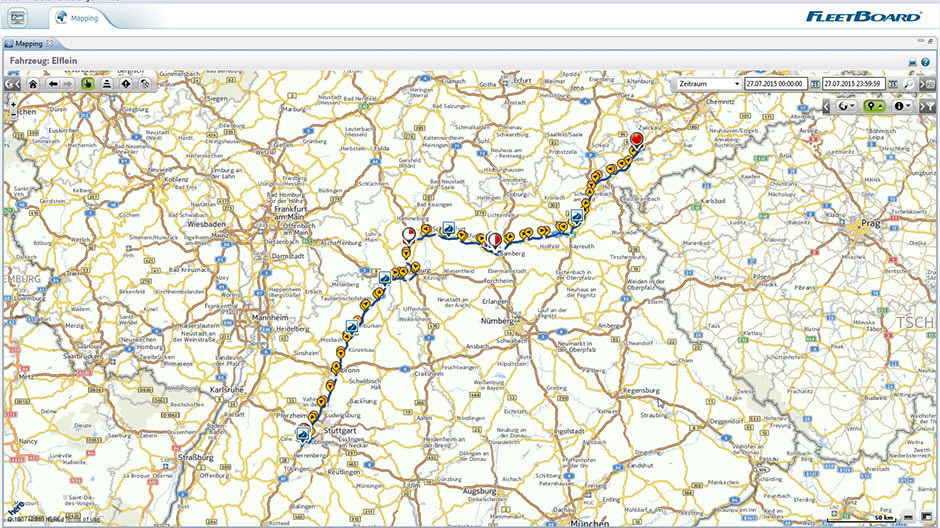
Große-Vehne.
The Grosse-Vehne transport company was established in 1974. Today, Grosse-Vehne has over 750 vehicles in operation across Europe. Under the name of GV Trucknet, the company currently consists of ten transport and logistics firms at seven sites in Germany, Romania and Slovakia.
The company has developed over the years into one of the leading providers of transport and logistics services. Alongside long-haul international transport, its main areas of business are in the automotive and paper industries as well as network distribution and textile logistics. GV Trucknet has three firmly established pillars of sustainability. These are Environment, Efficiency and Social. The company is a partner of the Centre for Sustainable Corporate Governance at the University of Witten/Herdecke and a participant in the “Round Table for Sustainability” of the Institute for Sustainability in Transport and Logistics at Heilbronn University.
Against this background, the Efficiency Run was given the fullest support by GV Trucknet. Managing Director René Grosse-Vehne: “To enable the transport industry to make its long-term contribution to CO2 reduction and, therefore, to climate protection, it is necessary already today to implement measures to cut CO2 emissions. And the Efficiency Run has confirmed that these include short-term measures that are effective and necessary, and which are already available on the market - such as Predictive Powertrain Control.”
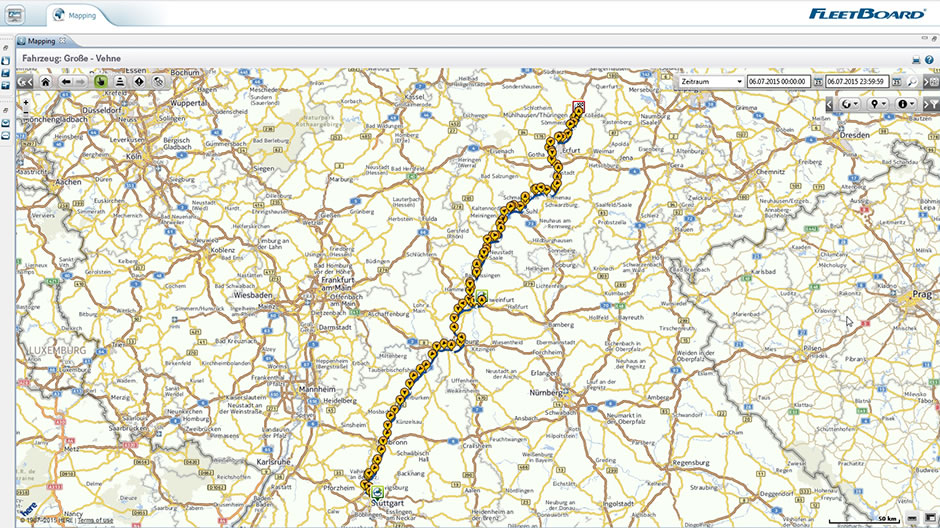
Krone.
Headquartered in Spelle (Lower Saxony), the Krone Group has two strings to its bow. While the products of its agricultural division are sold around the world, the commercial vehicles division (Fahrzeugwerk Bernard Krone GmbH and various subsidiaries) is focused on the European market, North Africa, Turkey and Central Asia. The main site for the commercial vehicles division is the plant in Werlte, which produces around 25,000 vehicle units per year – from traditional trailers and swap-body systems to state-of-the-art semitrailers. The plant in Werlte now ranks as the biggest producer of semitrailers in Europe.
In both producing and developing new vehicles, Krone is committed to a policy of sustainability and to driving forward innovation, including on the environmental front. The company therefore promotes the use of renewable energy sources as well as the reduction of CO2 emissions in its manufacturing processes.
The company's four German production sites in Werlte, Herzlake, Lübtheen and Dinklage as well as its Turkish plant in Tire employ a total of around 1700 people. In spite of its global operations, Krone has remained a family-run business and is currently run by Bernard Krone of the fourth generation.



Comment
Please log in to post a comment.
No comments yet